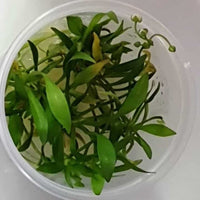SMALL 1909
Common Names: Amazon sword
Division: Magnoliophyta
Class: Liliopsida
Order: Alismatales
Family: Alismataceae
Native Distribution: Central and South America
Aquarium Placement: Background
Requirements: Adaptable to a wide range of conditions
Description:
The Amazon sword has been widely used in the aquarium hobby for decades. Until recently, “Amazon sword” was the common name for a few larger Echinodorus species found in or near the Amazon River Basin, specifically E. amazonicus and E. bleherae. However, based on DNA testing done in 2008, those former species are now considered to be synonymous with E. grisebachii. For more data on that, refer to Kew Bulletin Vol. 63: 525–563 (2008).
Amazon sword species can vary greatly in appearance and the conditions in which they grow. They can tolerate soft or hard water in a wide range of pH values, and temperature is not overly important, as long as it is kept in a reasonable tropical range. While the two most common Amazon swords have been grouped into a single species, there is still some difference in the conditions tolerated by them and their growth. The former E. amazonicus, for example, prefers softer water and reaches a shorter height of 16 to 20 inches. The variety formerly called E. bleherae, on the other hand, will tolerate hard water and can reach over 20 inches in height and girth.
Amazon swords of all kinds prefer a deep substrate of at least 4 inches to accommodate a massive root system. However, this is only needed when the plants will be grown with moderate to high light and supplemented with nutrients. In a low-light tank, the plant will grow very slow and not fully develop such a large root system, although it will still benefit from a supplemental root fertiliser.
Use in Aquascaping:
Echinodorus grisebachii is best suited to the background of very large aquaria. However, many hobbyists use it as a focal point in the mid ground of the aquascapes. Its large leaves provide good contrast to smaller-leaved plants, which would include the majority of aquatic species. The leaves have a rich green colour and can often exhibit some red/bronze coloration in newly emerging leaves.
In some fish-dominated aquaria, where a group of swords may be the only significant plants, Amazon swords have been known to be the preferred breeding spot for certain egg-laying cichlids such as angelfish. The large and wide leaves can provide shelter and even territory for many fish.
Perhaps a less publicised use for this plant, yet just as important, is for hiding unsightly aquarium equipment in the aquascapes. Heaters, filter intakes, cords hanging over the edge of the tank, thermometers, etc., can all be effectively concealed by the large and densely leaved sword plant.
Propagation: Amazon swords can be propagated by splitting a large plant into smaller plants by removing it from the substrate and carefully cutting the crown. They also send up submersed stalks, upon which several plantlets will form. These plantlets can be removed after they begin to form roots. If the stalk is left attached to the mother plant, it can produce many baby swords over a long period of time. With high lighting or very humid outdoor conditions, these swords can also be flowered and pollinated with a cotton swab or soft brush. Once the seed matures, it can be harvested and sown to produce new emergent plants
Reference: http://www.tfhmagazine.com/details/plant-of-the-month/echinodorus-grisebachii.htm







